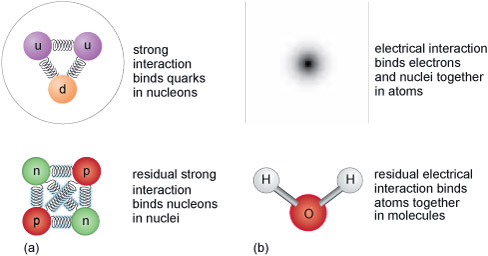6 Strong interactions
As introduced in Section 4, the force that binds quarks together inside nucleons (i.e. neutrons and protons) is known as the strong interaction and has a very short range. It operates essentially only within the size of a nucleon.
When two up quarks and a down quark form a proton, or when two down quarks and an up quark form a neutron, the strong interaction has, largely, done its job, in much the same way, for example, that the electric interaction between a proton and an electron does its job by forming a hydrogen atom.
In addition, there is a residual strong interaction between nucleons, which you can imagine as ‘leaking out’ of the individual protons and neutrons. This is sufficient to bind them together in nuclei and is similar in nature to the residual electromagnetic interactions between atoms that are responsible for the formation of molecules.

